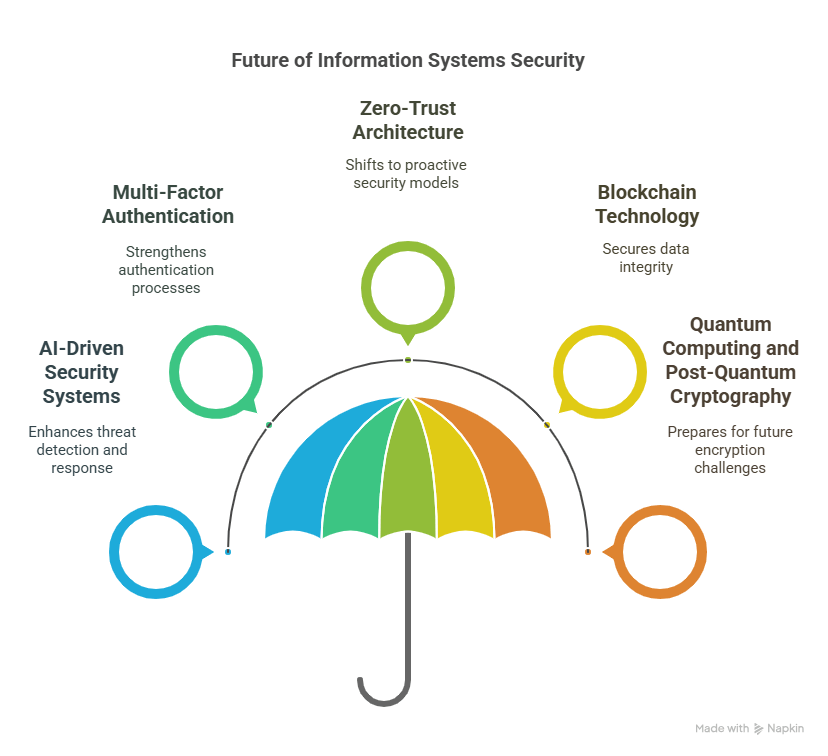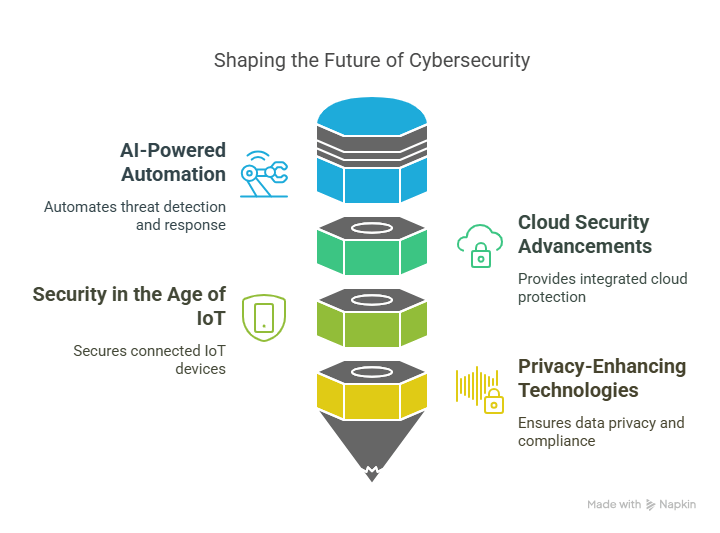As the digital world continues to evolve, information systems are increasingly vulnerable to sophisticated cyber threats. With organizations storing massive amounts of critical data, ensuring its protection is a growing concern. Security technologies are at the forefront of this battle, continually developing to meet the challenges of emerging threats.
The landscape of cybersecurity is shifting towards more advanced, intelligent solutions that can anticipate and prevent attacks. By 2025, the cybersecurity industry will witness revolutionary changes in the way information systems are secured. This blog will explore how these technologies are reshaping the future of information systems, focusing on key trends, innovations, and the role of Free Cybersecurity Certification Reddit in preparing professionals for the future.
The Growing Importance of Security Technologies
In today’s interconnected world, security has become more than just a concern for IT professionals. With the rise of cloud computing, big data, and mobile devices, every individual and organization relies on secure digital infrastructure. From personal banking apps to large enterprise networks, vulnerabilities in information systems can result in massive financial losses and damage to reputation.
The evolution of security technology is driven by the rapid increase in digital transformation across sectors. By 2025, security technologies will not only help mitigate risks but also enhance the efficiency and reliability of information systems, enabling businesses to continue their operations securely in a constantly evolving threat landscape.
Key Security Technologies Shaping Information Systems

1. AI-Driven Security Systems: Transforming Threat Detection and Response
Artificial intelligence (AI) has the potential to revolutionize how we detect and respond to cybersecurity threats. Unlike traditional methods that rely on predefined signatures to identify attacks, AI systems can learn from vast datasets to recognize anomalies, anticipate attacks, and respond autonomously.
Why AI Is Critical for Information Systems in 2025:
-
Real-Time Threat Detection: AI systems analyze vast amounts of data at lightning speed, which allows them to identify threats before they can do significant damage. This is critical as the volume of data generated by businesses continues to rise.
-
Self-Learning Algorithms: Machine learning algorithms help AI systems evolve by learning from past incidents. This self-improvement makes AI-driven security systems more effective over time, offering better protection.
-
Automation: By automating threat detection and response, AI reduces the need for human intervention, thus speeding up the security process and minimizing the risk of human error.
In 2025, AI-powered security will become ubiquitous in protecting information systems, providing faster, more accurate, and automated responses to increasingly complex cyber threats.
2. Multi-Factor Authentication (MFA): Strengthening Authentication Processes
Multi-factor authentication (MFA) adds an extra layer of protection by requiring more than one method of verification to access a system. In 2025, MFA will not just be for financial institutions but a necessary security measure for any organization storing sensitive data.
How MFA Will Shape the Future of Information Systems:
-
Multi-Layered Defense: MFA combines something the user knows (password), something the user has (a phone or hardware token), and something the user is (biometric data) to ensure the authenticity of access requests.
-
Prevention of Unauthorized Access: Even if a password is compromised, MFA ensures that unauthorized users cannot gain access without the second or third verification step, significantly reducing the risk of breaches.
-
User Adoption: As security risks grow, MFA will become standardized across industries, particularly in sectors like healthcare, finance, and government, where sensitive data is frequently targeted.
By 2025, MFA will become a mandatory security feature for businesses, ensuring that data remains secure even in the event of credential theft.
3. Zero-Trust Architecture: Shifting to Proactive Security Models
Zero-trust architecture (ZTA) is based on the premise that no one, whether inside or outside the organization’s network, should be trusted by default. This security model is rapidly gaining popularity as a way to secure information systems, especially as businesses increasingly adopt remote work and cloud-based infrastructures.
Why Zero-Trust is Essential for the Future of Information Systems:
-
Continuous Verification: Zero-trust continuously verifies users and devices, regardless of their location. This ensures that access to sensitive information is granted only to those with valid and current permissions.
-
Minimized Risk of Internal Breaches: In a zero-trust model, even users with internal network access must continuously prove their identity and the integrity of their devices, reducing the risks posed by insider threats.
-
Adaptability: Zero-trust can be applied across various systems, including on-premise, cloud, and hybrid environments, ensuring comprehensive protection across the organization.
By 2025, organizations will increasingly adopt zero-trust models as their primary security architecture to minimize internal and external threats.
4. Blockchain Technology: Securing Data Integrity
Blockchain technology, best known for its use in cryptocurrencies, is now being explored as a way to enhance data integrity and security in information systems. By 2025, blockchain is expected to play a crucial role in sectors like healthcare, supply chain, and finance, where data integrity is paramount.
How Blockchain Will Shape Information Systems:
-
Immutable Data Records: Blockchain records are decentralized and immutable, meaning once a piece of data is entered, it cannot be altered without being detected. This is crucial for securing sensitive information in industries like finance and healthcare.
-
Transparency: Blockchain ensures that all parties involved in a transaction can verify its legitimacy. This transparency reduces the risk of fraud and data tampering.
-
Decentralized Security: Blockchain’s decentralized nature means that no single entity controls the data, reducing the likelihood of data breaches caused by centralized vulnerabilities.
As the use of blockchain grows, it will become a powerful tool in securing digital transactions, ensuring that information systems remain transparent and tamper-proof.
5. Quantum Computing and Post-Quantum Cryptography: Preparing for the Future
Quantum computing, which harnesses the power of quantum mechanics to process information at unprecedented speeds, is set to challenge current cryptographic systems. By 2025, quantum computing could begin to break traditional encryption methods, prompting the need for quantum-safe encryption technologies.
Why Quantum Computing Will Transform Information Systems:
-
Breaking Traditional Encryption: Current encryption algorithms such as RSA are based on mathematical problems that quantum computers could solve in seconds. This makes existing encryption methods vulnerable to future quantum-powered attacks.
-
Post-Quantum Cryptography: As quantum computing advances, new cryptographic techniques will be developed to safeguard data against quantum decryption. This field, known as post-quantum cryptography, will become essential for securing information systems.
-
Quantum-Safe Security: Information systems will need to evolve to support quantum-resistant encryption algorithms that protect sensitive data from the growing capabilities of quantum computers.
As we approach 2025, organizations will need to prepare for the rise of quantum computing by adopting quantum-safe technologies to secure their data and systems.
Emerging Trends in Security Technology for 2025
As the cybersecurity landscape continues to evolve, new technologies are continuously emerging to address the unique challenges of securing information systems. Here are some key trends that will define the future of cybersecurity in 2025:

-
AI-Powered Automation: AI will increasingly automate threat detection, response, and system recovery, improving efficiency and reducing response time.
-
Cloud Security Advancements: As more organizations migrate to the cloud, cloud-native security tools will become more advanced, providing integrated, seamless protection.
-
Security in the Age of IoT: The explosion of Internet of Things (IoT) devices will necessitate specialized security measures to protect these connected systems from vulnerabilities.
-
Privacy-Enhancing Technologies (PETs): The rising concerns over data privacy will drive the development of privacy-enhancing technologies, ensuring that organizations remain compliant with regulations like GDPR.
These trends will help shape the information security strategies of the future, ensuring that information systems are more secure, efficient, and resilient.
Conclusion
In the next few years, security technologies will continue to shape the future of information systems, helping businesses defend against the increasingly sophisticated cyber threats of 2025 and beyond. From AI-driven security to blockchain-based data integrity, organizations must adopt these cutting-edge technologies to ensure the protection of sensitive information.
At ACSMI, we offer Cybersecurity Certifications that equip professionals with the skills to navigate these emerging security trends. Whether you are looking to expand your expertise or launch a career in cybersecurity, our certifications will help you stay ahead in the ever-evolving digital security landscape.
10 Lesser-Known Facts About Security Technology
-
AI is predicted to reduce cyberattack response times by up to 60%. (Source: IBM)
-
MFA can prevent 99.9% of account-related breaches. (Source: Microsoft)
-
Zero-trust architectures are especially effective in mitigating insider threats. (Source: Forbes)
-
Blockchain's decentralized nature makes it resistant to hacking. (Source: Harvard Business Review)
-
Quantum computing could potentially solve in seconds what would take classical computers millennia. (Source: MIT Technology Review)
-
AI-driven security systems are expected to save businesses billions annually. (Source: Gartner)
-
Blockchain can be used to verify the authenticity of digital files, such as legal contracts. (Source: Cloud Security Alliance)
-
AI systems can predict cyberattacks with a 70% accuracy rate based on historical data. (Source: McKinsey)
-
Blockchain is already being used to secure voting systems in some countries. (Source: TechCrunch)
-
By 2025, quantum-safe cryptography will be necessary for the protection of sensitive data. (Source: Quantum Computing Report)
FAQs
1. How does AI improve cybersecurity?
AI improves cybersecurity by automating threat detection, responding in real time, and learning from data patterns to anticipate new threats.
2. What is zero-trust architecture?
Zero-trust architecture assumes no one, inside or outside the network, is trusted by default. It continuously verifies every access request before granting permissions.
3. How will quantum computing affect encryption?
Quantum computers have the potential to break traditional encryption algorithms, requiring the development of quantum-safe cryptography to secure data.
4. What role does MFA play in cybersecurity?
MFA adds extra layers of security by requiring more than one verification method to grant access, greatly reducing the chances of unauthorized access.
5. Why is blockchain important for data security?
Blockchain ensures data integrity by creating immutable, transparent records that prevent unauthorized alterations, making it ideal for securing sensitive information.

Leave a Reply